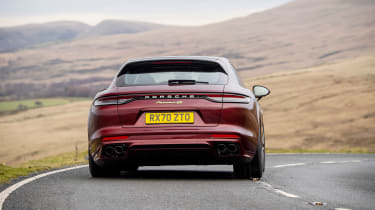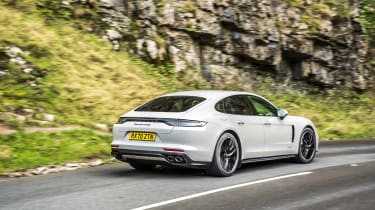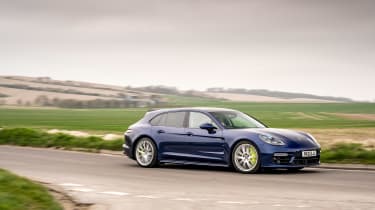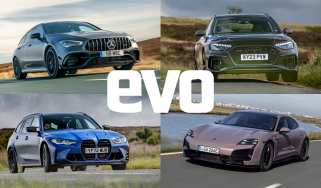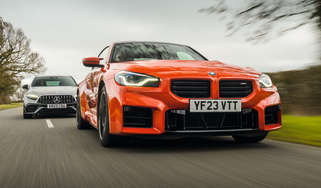Porsche Panamera (2016 - 2024) – ride and handling
For such a big and heavy car, the Panamera has incredible poise and control
Porsche’s big saloon and estate aren’t just quick in a straight line: they are just as enjoyable to drive when you turn off the autobahn. The seating position is low and there’s enough movement from the adjustable steering column to move the wheel to exactly where you want it.
It doesn’t ride like a luxurious barge, either. Instead there’s a tension to the way it deals with a road. However, it’s far from uncomfortable, the strong structure not allowing any nasty creaks, rattles or shudders.
The taut ride doesn’t try to disguise the Panamera’s size or weight – considering its enormity, that would be practically impossible. Instead, the Porsche manages its weight exceptionally well, with great body control that endows it with an intent rarely seen in a car of this sort. Its steering is heavy, especially around town, and so is the weight of the throttle. Such substantial controls emphasise that the Panamera isn’t some effortless city car, but they’re easy to adapt to and far from a hindrance. This solid feel, combined with its well-appointed cabin and high-speed performance, means the Panamera does a great job of being a comfortable GT car.
The steering rack, meanwhile, is quick and precise. There’s a significant amount of front grip, too, and you can direct the Panamera with remarkable accuracy. You do feel the car’s bulk when trying to slow it down, but the brakes are more than up to the task on the road. Such a reliable front end allows you to carry huge speed into a corner, so the full force of the brakes isn’t called upon quite as often as you might think.
More reviews
In-depth reviews
Reviews
Once turned in neatly, the Panamera gives you the confidence to jump on the power early and balance the car with the throttle through to the exit. The 4 E-Hybrid is eager, even from low down in the rev range. However, a lot of the time its V6 is muted and a little flat as the revs increase. Its built-in regenerative braking system also gives the brake pedal an extremely odd feel; it shuffles up and down beneath your foot as the system juggles between conventional brakes and the regen. Blending those two methods of braking seamlessly is a fiendishly difficult thing to do and, as it stands, Porsche is yet to master that art with this car.
> Read our full review of the Porsche Panamera 4 E-Hybrid
The GTS is the one that feels most like a Porsche. It’s not actually that fast, but the V8 emits a menacing grumble and pushes the Panamera along at a startling rate. It responds instantly to throttle inputs and there’s real force right up until its 7000rpm limit.
Its combustion-only powertrain also makes it more malleable in a corner, and liberal use of the throttle adds just a slight degree of attitude as the tyres lose their fight with the tarmac. Feeling the four-wheel-drive system hunt for grip, the tyres clawing away at the road, the GTS gives the impression it’s like a less extreme, less mechanical Nissan GT-R. It’s not as raw, exciting or quite as involving as the Japanese sports coupe, but for a four-door saloon to behave in that manner is deeply impressive.
The Turbo S takes this notion and carries it on with even more performance, but there is a caveat. With the extra performance, so comes extra chassis hardware that adds both an extra level of capability, but then also an extra layer of technology, and therefore vagueness to the overall chassis. It’s devastatingly fast, but the GTS’s purer chassis feel and ability to communicate right up to and just over the limit makes it the better driver’s Panamera. The 150-odd horsepower deficit is certainly noticeable, but then it also gives you more time to enjoy the V8 rumble before hitting some very unsociable speeds.
Just as the acceleration times aren’t affected by the extra weight of the Sport Turismo’s estate body, neither is its handling. The Panamera shares elements from its sports car siblings, with great weighting to its controls, a real agility, unshakable composure and masses of grip. However, it doesn’t feel like a true sports car. Instead it creates a character all of its own – one that’s less delicate, but still involving and enjoyable.

